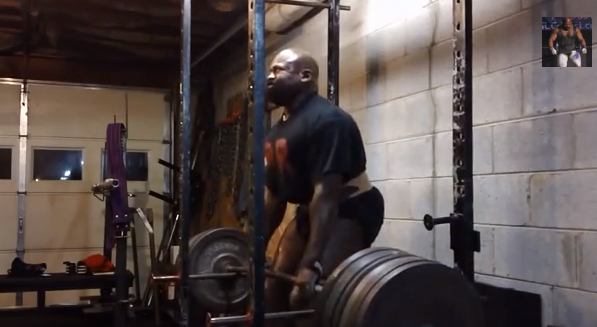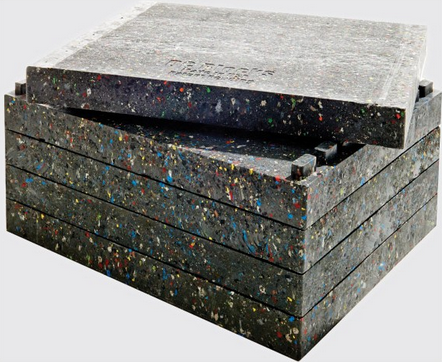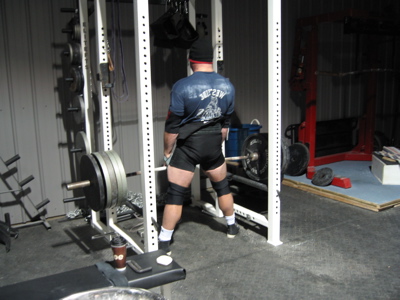
These two movements are not the same.
After seeing the response to THIS post about JM Presses with the SS Yoke bar I thought this would be a great topic top revisit.
1. When pulling with the weights on blocks or stands, the bar will flex the same as if you are pulling it off of the floor. The first point of contact, when pulling on the bar, are the plates loaded on each side.
2. When pulling off pins, the first point of contact is where the bar touches the pin that you are pulling off of. So, there will be less flex in the bar, and the flex will not be the same as if pulling from the floor or blocks, where the point of contact is out wider.
* This will vary depending on the type of bar, but is still a factor nonetheless.
3. Pulling off blocks makes it easier to get the bar position where you want it to be, because the bar rolls the same, as if it were on the floor.
4. If pulling off pins, you have to make sure that your body is positioned correctly, because the bar doesn't roll well on the pins. It usually moves in an awkward and uneven sliding motion. This usually means that you need to readjust your body or just pull in a non-optimal position.
5. Pulling off pins allows you to stay closer to the bar (shins or thighs, depending on height) because the bar will not roll away from you if your knees track forward on the descent. This also means that you may have to position the bar out in front more, if you are pulling from a lower pin.
In the case of a high pin pull, this is the difference between a movement that will help your lockout, and one that's just going to build your ego. Watch how Steve Goggins uses the high pin pull in the video below. He is not leg pressing the bar up, but is using his back and glutes to hinge the bar off the pins. To do this, he needs to keep his quads pushed into the bar as hard as (or harder than) it would be at the lockout of a full pull.
6. Pulling off blocks is also easier on your bar than being slammed against pins, but there are some considerations for each.
If using blocks:
- Make sure that the blocks are even in height and position.
- Make sure that they are big enough, so that the bar will not roll off the ends.
- Measure the height, so you can replicate it for progression and record keeping.
- Note which bar you used, as the whip and bench of the bar matters.
- If you slam the weights down, you'll increase the likelihood of the plates coming apart and the collars falling off.
- Regardless of collars, it's always a good idea to use more than one per side and to keep the plates a little loose.
- Making the first plate a bumper plate can ease up on the force of each rep on the box, assuming that the blocks are not rubber.
Off pins:
- If your rack has rod and pipe safeties - USE THEM. These displace the weight on impact, and can help save the bars. This is the exact reason why these were made; think about it. If the safety is the hard iron I-beam, and the bar hits the beam, most of the force of the hit will be displaced to the bar, as the beam has zero give to it. If the safety is a rod and pin, much of the force will be displaced through the safety, because the pipe moves around the pin. Check out the low pin pull video above to see what I am talking about. Yes, these are more of a pain in the ass to set up, but it only takes a few extra minutes and will help save, not only the barbells and safeties, but also your back, bicep tendons, and shoulders. If you do not have rod and pin safeties and do pin pulls, then do not drop the bar on the pins, ever.
- Use the right bar. A good gym will have bars marked for pin pull use; only use these. These are usually an old deadlift bar, or an old bar that got bent due to another member using it for something other than it's intended use. Don't assume, ask.
If you are unwilling to buy it - don't bend it!
- Even with rod and pin safeties, there is more displaced force with the pin pull than blocks, so it's best to keep the pin pulls to sets of 1-3 reps, and to save the high rep sets for blocks or dead stop deadlifts.
There are advantages and disadvantages to each approach, based on what you are trying to build, your sticking point, and what you have to work with. For example, if you have a hard time straining for time, or thinking when you strain, a pin pull is a great option, because (for most) it takes longer to get the bar to break the pins.











